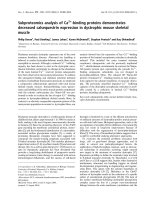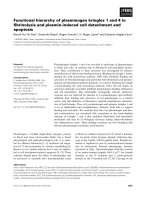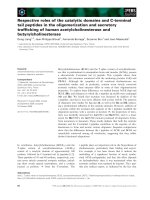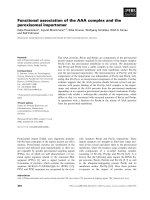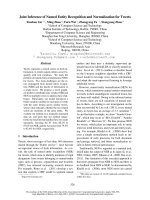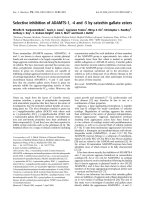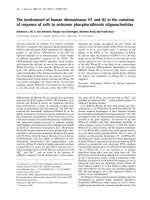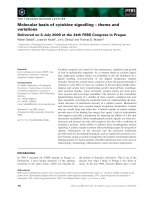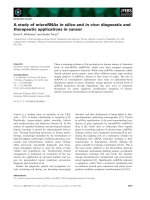Báo cáo khoa học: "Recurrence patterns of locally advanced head and neck squamous cell carcinoma after 3D conformal (chemo)-radiotherapy" pdf
Bạn đang xem bản rút gọn của tài liệu. Xem và tải ngay bản đầy đủ của tài liệu tại đây (3.31 MB, 11 trang )
RESEARCH Open Access
Recurrence patterns of locally advanced head
and neck squamous cell carcinoma after 3D
conformal (chemo)-radiotherapy
Didem C Oksuz
1
, Robin J Prestwich
1
, Brendan Carey
1
, Stuart Wilson
1
, Mustafa S Senocak
2
, Ananya Choudhury
3
,
Karen Dyker
1
, Catherine Coyle
1
and Mehmet Sen
1*
Abstract
Background: To establish recurrence patterns among locally advanced head and neck non-nasopharyngeal
squamous cell carcinoma (HNSCC) patients treated with radical (chemo-) radiotherapy and to correlate the sites of
loco-regional recurrence with radiotherapy doses and target volumes
Method: 151 locally advanced HNSC C patients were treated between 2004-2005 using radical three-dimensional
conformal radiotherapy. Patients with prior surgery to the primary tumour site were excluded. The sites of
locoregional relapses were correlated with radiotherapy plans by the radiologist and a planning dosimetrist.
Results: Median age was 59 years (range:34-89). 35 patients had stage III disease, 116 patients had sta ge IV A/B.
36 patients were treated with radiotherapy alone, 42 with induction chemotherapy, 63 with induction and
concomitant chemoradiotherapy and 10 concomitant chemoradiotherapy. Median follow-up was 38 months
(range 3-62). 3-year cause specific survival was 66.8%. 125 of 151 (82.8%) achieved a complete response to
treatment. Amongst these 125 there were 20 local-regional recurrence, comprising 8 local, 5 regional and 7
simultaneous local and regional; synchronous distant metastases occurred in 7 of the 20. 9 patients developed
distant metastases in the absence of locoregional failure. For the 14 local recurrences with planning data available,
12 were in-field, 1 was marginal, and 1 was out-of-field. Of the 11 regional failures with planning data available,
7 were in-field, 1 was marginal and 3 were out-of-field recurrences.
Conclusion: The majority of failures following non-surgical treatment for locally advanced HNSCC were loco-
regional, within the radiotherapy target volume. Improv ing locoregional control remains a high priority.
Introduction
Head-and-neck squamous cell carcinoma (HNSCC) is
the sixth most common malignancy worldwide, responsi-
ble for approximately half a million new cases every year
[1]. Approximately 60% of patients with HNSCC present
with locally advanced, but non-m etastatic disease (stage-
III or IVA/B) at diagnosis. Based upon organ preservation
studies [2,3], radiotherapy is an accepted alternative to
surgery. The results of radical radiotherapy regimens
have been further improved by the use of induction che-
motherapy [4], concurrent chemoradiotherapy [4], and
concurrent epidermal growth factor inhibitors [5].
In parallel, radiotherapy techniques have developed
rapidly; conformal radiotherapy (CRT), accelerated sche-
dules [6] and intensity modulated radiotherapy (IMRT)
[7] have been used to improve the therapeutic ratio
between tumour control and normal tissue toxicity.
Historically, locoregional failure has been the predo-
minant pattern of relapse following non-surgical treat-
ment [8]. With the rapid advancement of non-surgical
treatment strategies, it is critical to document the pat-
tern of treatment failure in relation to, the radiotherapy
dose distributions. These data are required to guide
whether future improvements should be focused on
improving local and/or regional control or, on reducing
the development of distant metastases (DM). The for-
mer may involve modifications in target volume
* Correspondence:
1
St James’s Institute of Oncology, Leeds, UK
Full list of author information is available at the end of the article
Oksuz et al. Radiation Oncology 2011, 6:54
/>© 2011 Oksuz et al; licensee BioMed Central Ltd. This is an Open Access article distributed under the terms of the Creative Commons
Attribution License (http://creativecom mons .org/licenses/by/2.0), which permits unrestricted use, distribution, and reproduction in
any medium, provided the original work is prope rly cited.
definition, delivery technique, or dose escalation. How-
ever, if DM is an increasing problem, consideration
could be given to prioritizing the delivery of systemically
active therapy. Therefore, the aim of this retrospec tive
study is to determine recurrence patterns among
HNSCC patients treated with radical three-dimensional
(3D) CRT with or without chemotherapy, and to corre-
late the sites of local-regional recurrence (LRR) to pre-
viously treated radiotherapy fields and dose distribution.
Materials and methods
After institutional review board approval, we retrospec-
tively reviewed the medical re cords of patients with
locally advanced stage III/IV HNSCC treated with 3D-
CRT w ith curative intent at the Yorkshire Cancer Cen-
tre b etween January 2004 and December 2005. Patients
with nasopharynx carcinomas were excluded. Patients
who had undergone initial therapeutic surgery to the
primary tumour site were excluded.
Pre-treatment work up
Diagnostic staging routinely consisted of physical exami-
nation, nasoendoscopy, com puted tomography (CT) or
magnetic resonance imaging (MRI) scans of the head
and neck, CT of thorax, direct endoscopy under anaes-
thesia and histological confirmation.
Radiotherapy treatment planning
The patients were t reated supine, i mmobilised with a
beam directional perspex shell. CT images for treatment
planning were obtained at 2-5 mm intervals from the
vertex to below the carina. The CT data was loaded into
the Helax-TMS VG-1B treatment planning system. One
of two methods was routinely used for target volume
definition. The first of t hese was utilised for patients
who were to be treated using a parallel opposed pair to
the high dose region; a planning target volume (PTV)
was directly defined using virtual simulation. The need
to outline a gross tumour volume (GTV) and clinical
target volume (CTV) to aid definition of the PTV was at
the discretion of the clinician. The second method of
outlining the target volume was used for patients who
were not inten ded to b e treated with parallel opposed
pair. A GTV was outlined as primary tumour and clini-
cally and/or radiologically involved lymph nodes. A
CTV was created to include areas and lymph nodes at
high risk of tumour involvement; this was by auto-
expanding the GTV by 10-20 mm, individualising this
to exclude areas of air or bone without evidence of
tumour invasion, and expanding the CTV to include
high risk nodal areas. In general, bilateral level II, III, IV
and V lymph nodes were included within the CTV with
some exceptions relating to patients’ co-morbidities.
Level IB and retropharyngeal lymph nodes were variably
included dependin g on tumour site and stage. The CTV
was subsequently expanded automatically in 3D by 3-5
mm to create a PTV.
Organs at risk were routinely outlined on the planning
CT images. For conventionally fractionated treatment
schedules ( 2Gy per fraction) a maximum dose of 46Gy
to spinal cord, 54Gy to brainstem was accepted. For the
accelerated hypofractionated schedule of 55Gy in 20
fractions, a maximum dose of 40Gy to spinal cord,
42Gy to brainstem was accepted.
Radio therapy was with 6 MV photons ± posterior elec-
tron fields. Treatment was commonly planned using a 2
phase technique of lateral opposed pair of multiple field-
in-fields, with the posterior border moved anterior to
spinal cord prior to reaching s pinal cord tolerance and
matched posterior electron fields used to treat nodal
areas overlying the cord. A 6 MV photon anterior neck
field was matched geometrically to the lateral opposed
photon fields. Alternatively, following definition of con-
toured target volumes, treatment was with a single phase
conformal 5-7 field plan. Treatment was planne d to pro-
vide adequate coverage of the primary target and lymph
nodes at risk according to ICRU-62 guidelines [9].
During the period of the study, different radical radio-
therapy regimes were in standard use. The most com-
monly used schedules were conventionally fractionated
66-70Gy in 33-35 fractions, and an accelerated hypofrac-
tionated schedule of 55Gy in 20 fractions, prescribed to
the 100% isodose within the PTV. The choice of con-
ventionally or hypofractionated radiotherapy reflected
historical practice and clinician preference. Using the
lateral opposed pair technique, an anterior neck field of
50Gy in 25 fractions f or the conventionally fractionated
regimenor40Gyin15forthehypofractionatedregi-
men, was us ed. All patients were treated once daily, five
times a week.
Chemotherapy
The use of chemotherapy was based upon clinicians’
assessment of multiple factors, including a ge, co-mor-
bidity, performance status, tumour extent and socia l
support. For patients who were treated with induction
chemotherapy, chemotherapy was administered as 2-3
cycles of cisplatin 80 mg/m
2
Day1 and 5-fluorouracil
800 mg/m
2
Days 2-5, every three weeks. For patients
treated with concomitant chemotherapy, cisplatin 100
mg/m
2
was delivered up to three times for convention-
ally fractionated sc hedules at 3 week in terv als, and at a
dose of 80 mg/m
2
on day 1 and 28 of the four week
hypofractionated radiotherapy schedule.
Analysis of response to treatment and follow-up
Tumour response was assessed 4 months after the com-
pletion of the treat ment. Evaluation of tumour response
Oksuz et al. Radiation Oncology 2011, 6:54
/>Page 2 of 11
consisted of clinical examination, nasopharyngolaryngo-
scopy and CT or MRI imaging of the primary site and
the neck. Any suspicious findings in the primary tumour
site or neck were evaluated by biopsy. Patients with less
than a complete response (CR) were evaluated for sal-
vage surgery. All patients were routinely followed up
with physical examination and flexible endoscopy every
6-8 weeks in the first year after treatment, every 3
months for an additional 2 years, every 6 months years
4 and 5.
Definition of failure site
Each local or regional treatment failure site was con-
firmed pathologically and reviewed within the multidis-
ciplinary head-and-neck team. As part of the study, the
imaging of the all patients who experienced LRR was
reviewed by a head and neck specialist diagnostic radiol-
ogist, to identify the prec ise site of LRR. The radiologist,
using information on the imaging demonstrating recur-
rence, including size of recurrence and relationship to
anatomical structures, reconstructed the recurrent
volume of tumour (Vrecur) by contouri ng, on the origi-
nal planning CT images. The original treatment plan
was applied, and dose volume histograms (DVH) were
obtained for the reconstructed recurrent tumour. The
local and regional recurrences were classified as “in-
field,” in which 95% or more of the Vrecur w as within
the 95% isodose based upon DVH assessment; “ mar -
ginal,” in which 20% to 94% of Vrecur was within the
95% isodose; or “out -of-field,” in which less than 20% of
Vrecur was within the 95% isodose line (Figure 1,2).
Recurrences were defined as local if they were within
thezoneoftheprimarytumour,andasregionalifthey
occurred elsewhere including neck lymph nodes.
Statistical analysis
All statistical computations were performed using
PASW-18. Variables were compared using student-t,
Mann-Whitney-U or chi-square test according to the
variable properties. Kaplan-Meier analysis with a log-
rank test was used for survival analysis. The Cox pro-
portional hazards regression model was used fo r multi-
variate survival analyses. Survival was calcul ated from
the date of diagnosis. Locoregional control (LRC) time
was defined as the time from the date of diagnosis to
date of local or regional relapse. For distant metastases
free surviv al (DMFS), first recurrence at distant site was
taken as an event. Salvage of recurrences was not
included in the evaluation of LRC or progression-free
survival (PFS). For the PFS analysis, progression was
defined as locoregional progression or distant progres-
sion. Cause-specific survival (CSS) events were defined
as death from cancer or treatment complications.
Results
Patient and tumour characteristics
A total of 151 patients with locally advanced non-naso-
pharyngeal HNSCC were treated at the Yorkshire Can-
cer Centre between January 2004 a nd December 2005
using 3D-CRT with or without chemotherapy. 7 patients
had undergone prior uni lateral neck dissections. One
hundred and nine (72%) were male. Median age was 59
years (range: 34-89 years).
Tumour and treatment characteristics are summarized
in Table 1. The primary tumour site was the oropharynx
in 81 patients (54%), the larynx in 32 (21%), the hypo-
pharynx in 21 (14%), t he oral cavity in 14 (9%). All
patients had histologically confirmed squamous cell car-
cinoma. Histological grading was recorded in 134
patients and 76 (50. 3%) had poorly differentiated squa-
mous cell carcinoma. Stage distribution was classified
according to the 2002 TNM staging system of American
Joint Committee on Cancer (AJCC). Thirty-five (23%)
patients had stage III disease while 116 (77%) patients
had stage IV A/B (Table 2).
Treatment details
One hundred and fifteen (76 .2%) patients were treated
with a combination of chemotherapy and radiotherapy.
Of these 115 patients, 42 (36.5%) patients were treated
with induction chemotherapy followed by radiotherapy,
63 (54.7%) patients with induction chemotherapy and
concomitant chemoradiotherapy and 10 patients (8.7%)
with concomitant chemoradiotherapy. Thirty-four of 73
patients received 2 or more cycles. The remaining 36
patients were treated with radiotherapy alone (Table 1).
The majority of patients were treated with hypofrac-
tionated radiotherapy. 80 patients received 55 Gy in 20
fractions and 14 patients r eceived other hypofractio-
nated regimes (i.e. 3 patients with 60 Gy in 25 fractions
or 11 patients with 65 Gy in 30 fractions). 50 patients
were treated with conventional radiotherapy (i.e. median
68 Gy (range: 66-70 Gy) in once daily fractions of 2 Gy
each). Seven of 151 (4.6%) patients did not receive the
planned radiotherapy dose. In five cases this was due to
acute treatment toxicity necessitating a reduced total
dose, one patient had disease progression during treat-
ment and one patient suffered colonic perforation.
Response to treatment
After induction chemotherapy 84/105 patients (80%)
had a clinical CR or PR. One hundred and seventeen of
151 (77.5%) patients had CR 4 months after their radical
treatment. Patients with a PR (14.6%), stable (0.7%) or
progressive (2%) disease were evaluated for salvage treat-
ment. Eight patients underwent salvage surgery (5 neck
dissections and 3 laryngectomies ± neck dissections) for
Oksuz et al. Radiation Oncology 2011, 6:54
/>Page 3 of 11
residual disease achieving complete macroscopic tumour
clearance. Tumour response was not assessed in 8
patients (5.3%) because of death from toxicity (6
patients) or unrelated causes (2 patients). Thus, includ-
ing salvage surgery, 125 of 151 (82.8%) patients achieved
a CR to treatment.
Survival rates
The median follow-up of all patients was 38 months
(range:3-62 months). Forty four (29.1%) patients died of
cancer, 17 (11.3%) of intercurren t disease. Treatment
related deaths occurred in 6 (4%) patients with 5 dying
of aspiration pneumonia. Three out of 6 died after the
completion of 55Gy in 20 fractions over 4 weeks. For
the entire co hort of 151 patients the OS rates were
67.5% and 58.3%; the CSS rates were 75.1% and 66.8%
and PFS rates were 72.5% and 67.2% at 2 and 3-years
respectively.
Patterns of recurrence of patients who had CR after the
treatment
Median follow up for the 125 who achieved a CR to
treatment, (including the 8 patients who underwent sal-
vage surgery) was 40 months (range:6-62 months). The
patterns of subsequent failure in these patients are
shown in Figure 3. Disease recurred in total of 29 of the
125 patients. The median time to failure of these 29
patients was 18 months (rang e:7-38 months). Seven
Figure 1 Reconstruction of site of tumour rec urrence on pretreatm ent planning CT and DVH anal ysis to de termine the sit e of
recurrence in relationship to treatment volume: An example of out-of-field recurrent tumour in a patient with T2N1 oral cavity tumor
(patient-5).
Oksuz et al. Radiation Oncology 2011, 6:54
/>Page 4 of 11
patients developed isolated local recurrence with a med-
ian time to recurrence of 16 months ( range:13-23
months). One of these patients underwent a salvage lar-
yngectomy, and has subsequently remained disease free.
A combination of local and regional recurrence (in the
absence of DM) occurred in 4 patients after median
13.5 months (range:12-17 months) and 3 of these under-
went salvage surgery. T wo patients had an isolat ed
regional recurrence, occurring at 13 and 22 months; one
patient was treated with palliative chemotherapy and the
other with best supportive care alone. Hence overall, a
total of 20 out of 125 patients experienced local and/or
regional failure with a median time to failure of 16.5
months (range:11-26 months). Among the complete
responders , 3-year local and regional contro l rates were
86.8% and 89.5%, respectively. A total of 16 of 125
patients with CR developed DM after a median of 22.5
months (range 7-38 months). The 3-year DMFS rate in
patients with CR was 87.3%.
The details of patients and tumours in cases, where
LRR were noted, are provided in Table 3. R adiotherapy
planning CT images were available for 19 of the 20
Figure 2 Reconstruction of site of tumour rec urrence on pretreatm ent planning CT and DVH anal ysis to de termine the sit e of
recurrence in relationship to treatment volume: An example of infield recurrent tumour in a patient with T4N0 hypopharynx tumor
(patient-14).
Oksuz et al. Radiation Oncology 2011, 6:54
/>Page 5 of 11
patients. For the 14 local recurrences with planning data
available, 12 recurrences were in-field, 1 was marginal,
and 1 was o ut-of-field. Of the 11 regional failures with
planning data available, 6 were in-field, 1 was marginal ,
3 were out-of-field recurrences, a nd one patient experi-
enced both infield (right side) and outfield (left side)
recurrences. Patients with laryngeal cancer had the most
LRR; they accounted for 50% of all recurrences although
they only comprised 21.2% of all tumours. Twelve of 20
LRR patients received 55 Gy in 20 fractions of radio-
therapy, and 9 of these patients experienced in-field
recurrences.
6ofthetotalof20casesofLRRoccurredinthe
group of 8 patients who had had a less than CR to non-
surgical treatment and had subsequently undergone
salvage surgery. In 5 of these 6 cases recurrence was in-
field, and one was a marginal recurrence. All 3 of the
patients who underwent a salvage laryngectomy devel-
oped an in-field stomal recurrence (patients 8,9,11).
Among the patients with isolated in-fiel d recurrences, 3
patients had undergone a right radical n eck dissection
prior to radiotherapy, and 2 of these patients recurred
in right neck with synchronous DM (patients 3,15).
Although the majority of treatments were bilateral, uni-
lateral treatment was delivered in 9 patients based upon
tumour stage, prior neck dissections or patient factors.
However, only two out-of-field recurrences were in the
untreated contralateral neck. These two patients also
had simultaneous DM. In addition, 2 out-of-field regio-
nal relapses were associated with omission of high risk
elective lymph node regions from CTV at the time of
radiotherapy planning. In an 87 years old patient with
T2N1 oral cavity tumour, the radiotherapy field was
limited to the right upper neck because of age and co-
morbidities (patient 5, Figure 1). The anterior neck and
level VI lymph node regions were not included in CTV
in a case with a T4AN0 glottic larynx (patient 2). The
single case of an outfield local recurrence occurred in a
patient with T4AN2C oropharyngeal tumor (patient 19);
this patient had not been treated with standard radio-
therapy techniques and had a high field match with the
lower neck field in order to spare the larynx.
Prognostic factors
On univariate analysis of all patients age, T stage, and
tumour subsite were examined for their relationship with
PFS and CSS (Table 4). Patients older than 60 years had
significantly lower PFS (p = 0.013) and CSS (p = 0.002)
rates. In addition, CSS (p = 0.0003) and PFS (p = 0.0002)
rates were significantly higher in patients with T1-T2 dis-
ease compared with T3-4 disease. Both the PFS and CSS
rates were s ignificantly better for patients with orophar-
yngeal tumour compared to non-oropharyngeal tumours
Table 1 Tumour and treatment characteristics for all
patients
N%
Primary tumour site
Oropharynx 81 53.6
Larynx 32 21.2
Hypopharynx 21 13.9
Oral cavity 14 9.3
Unknown primary 3 2
Histological grade of squamous cell carcinoma
Well differentiated 6 4
Moderately differentiated 52 34.4
Poorly differentiated 76 50.3
Not recorded 17 11.3
Overall stage (AJCC)
III 35 23.2
IVA 87 57.6
IVB 29 19.2
Treatment
Radical radiotherapy alone 36 23.8
Chemoradiotherapy (chemoXRT) 115
Induction chemo + XRT 42 27.9
Induction chemo + concomitant chemoXRT 63 41.7
Concomitant chemoXRT 10 6.6
Abbrevations: Chemo: chemotherapy; XRT : radiotherapy.
Table 2 Detailed distribution of primary tumour and
nodal stages
N0 N1 N2 N3 Total
T1 - 4 10 3 17
T2 - 12 15 5 32
T3 12 7 13 6 38
T4 18 7 28 8 61
TX 3-3
Total 30 30 69 22 151
Figure 3 The failure patterns of 125 patients who had
complete response after the treatment.
Oksuz et al. Radiation Oncology 2011, 6:54
/>Page 6 of 11
(p = 0.002 and p = 0.001 respectively). Nodal stage and
the use of chemotherapy were not statistically signifi cant
prognostic factors (Table 4). Variables evaluated by
multivariate analysis included age, tumour subsite and
T-stage. T-stage was found to be a significant indepen-
dent factor affecting both PFS and CSS rates (p = 0.0 06
and p = 0.008 respectively). Age and tumour subsite were
also independent prognostic factors with a limited signifi-
cance for CSS rate (p = 0.05) (Table 5).
Discussion
A critical aspect of the management of HNSCC is to
understand the pat terns of treatment failure, in orde r to
guide future attempts to optimize radiotherapy planning
Table 3 Details of patients who developed a local or/and regional failure
Pt.
no
Primary
tumor site
Stage XRT
dose
(Gy/fr)
Type of
relapse
Site of first failure Time to
failure (mo)
Type of
failure
Metastasis
Primary Radical radiotherapy
1. Hypopharynx T3N0 55/20fr L Right Hypopharynx 23 infield -
2. Larynx
(Glottic)
T4AN0 55/20fr L, R Anterior Ventricle
Level VI LN
17 Infield (L)
Outfield (R)
-
3. Oropharynx T1N2A 65/30fr R Right Level III LN
Left Level II, III, IV LN
21 Infield (Right
side)
Outfield (Left
side)
Lung
(Synchronous)
4. Larynx
(Supraglottic)
T3N0 55/20fr R Left Level II-III LN 11 Outfield Lung, bone
(Synchronous)
5. Oral cavity T2N1 55/20fr R Right Level IV-V-VI 13 Outfield -
6. Larynx
(Glottic)
T3N0 55/20fr L, R Glottic region
Level II-III LN
12 NA -
7. Oral cavity T4AN1 55/20fr L Left mandibular alveolus 14 Infield -
8. Larynx
(Glottic)
T4AN0 55/20fr L Stoma 26 Infield Lung
(Synchronous)
Concomitant chemoradiotherapy
9. Larynx
(supraglottic)
T1N2B 70/35fr L, R Base of tongue
Tumor nodules around stoma and skin
14 (L)
16 (R)
Infield -
Induction chemotherapy + radiotherapy
10. Larynx
(Supraglottic)
T4AN0 55/20fr L Epiglottis, vocal cord 11 Infield -
11. Larynx
(Supraglottic)
T3N3 55/20fr L, R Stoma
Left II, III, IV LN
24 Infield Lung
(Synchronous)
12. Oropharynx T4AN2C 55/20fr L, R Base of tongue, left tonsil
Left level II, III, IV LN
13 Infield -
13. Larynx
(supraglottic)
T3N2C 66/33fr L Supraglottic area 16 Infield -
14. Hypopharynx T4AN0 55/20fr L Post hypopharyngeal wall extending
upper oesophageous
16 Infield -
Induction chemotherapy + chemoradioherapy
15. Larynx
(Supraglottic)
T4AN2C 65/30fr R Right level II-III LN 12 Infield Bone
(Synchronous)
16. Hypopharynx T2N3 65/30fr L, R Postcricoid tumor with extensive nodal
spread
20 Marginal Lung
(Synchronous)
17. Oropharynx T4AN2B 68/34fr R Left level III-IV LN 22 Infield -
18. Oropharynx T3N3 70/35fr L, R Supraglottic region, inferior aryepiglottic
fold
Level IV LN
18 Infield Lung
(Synchronous)
19. Oropharynx T4AN2C 68/34fr L Right post parapharyngeal 23 Outfield -
20. Larynx
(Supraglottic)
T4N0 55/20fr L Right pyriform fossa 21 Infield -
Abbrevations: L: lo cal recurrence; R: regional recurrence; NA: not applicable; XRT: radiotherapy; LN: lymph node; fr: fraction.
Oksuz et al. Radiation Oncology 2011, 6:54
/>Page 7 of 11
and i mprove the therapeutic ratio. If treatment failures
are predominantly distant, intensification of systemic
therapy may be needed to improve outcomes. By con-
trast, if failures are loco-regional, this may emphasize
the need to identify patients with a radiation resistant
tumour subpopulation and underlie the rationale for
studies of dose escalation to the highest risk regions.
In this study, 82.8% of the patients achieved a com-
plete tumour respons e 4 months after completion of
therapy. The 4 month timepoint used here is intended
to allow adequate time for the response to radiotherapy.
Pacagnelli et al. showed that an 8 week response assess-
ment is too early, with more complete responses being
seen at 8 months than 8 weeks post-treatment [10]. We
have demonstrated that 3-year local and regional control
was high in these patients with rates of 86.8% and
89.5%, respectively. In 125 complete r esponders, there
were 20 LRR. Amongst the 117 patien ts who achieved a
CR to (chemo)-radiotherapy without salvage surgery,
therewereonly14LRR.Sixofthe8patientswhohad
undergone salvage surgery after a failure to achieve a
complete response had a locoregional recurrence and 5
of these cases failure was infield. One third of cases of
LRR were associated with the development of synchro-
nous DM. DM in the abse nce of LRR was unc ommon,
occurring in only 9 of 125 patients.
Analysis of patterns of failure in relation to the dosi-
metry of the radiotherapy plan, demonstrated that 76%
of LRR occurred within the PTV (12 of 14 local recur-
rences and 7 of 11 regional recurrences) . There were no
cases of isolated recurrences within the volume treated
by the lower dose prophylactic anterior neck fields. 12
of the patients with LRR had been treated with hypo-
fractionated 55Gy in 20 fractions. Based upon this data,
and national guidance [11], hypofractionated treatment
for locally advanced HNSCC has been abandoned in our
centre. Five patients had an out-of-field LRR. Four of
them were treated with r adical radiotherapy o nly. Two
Table 4 Univariate analysis of progression-free survival and cause-specific survival in all patients
PROGRESSION-FREE SURVIVAL CAUSE-SPECIFIC SURVIVAL
Factors N 3 years (%) P 3 years (%) P
Age group
≤60 years 83 75.8 0.013 75.9 0.002
>60 years 68 57 55.6
Tumour subsite
Oropharyngeal tumours 81 80.4 0.002 79.5 0.001
Non-oropharyngeal tumours 70 52 51.6
T stage
Tx, T1, T2 52 86.7 0.0002 87.6 0.0003
T3-T4 99 57.9 56.1
Nodal Status
N0-N1 60 73.6 0.395 70.7 0.369
N2-3 91 64.1 56.1
Treatment types
With Chemotherapy 115 70.4 0.409 69 0.266
Without chemotherapy 36 58.2 59.5
Table 5 Multivariate analysis of prognostic factors for progression-free survival and cause-specific survival
PROGRESSION-FREE SURVIVAL CAUSE-SPECIFIC SURVIVAL
P-value Hazard ratio (95% CI) P-value Hazard ratio (95% CI)
Age 0.117 0.05
≤60 years 0.658 (0.362-1.197) 0.559 (0.312-1.001)
>60 years 11
T stage 0.006 0.008
Tx, T1-T2 0.288 (0.12-0.694) 0.332 (0.146-0.753)
T3-T4 11
Tumour subsite 0.06 0.05
Oropharyngeal tumours 0.551 (0.297-1.021) 0.554 (0.305-1.005)
Non-oropharyngeal tumours 11
Abbrevations: CI: Confidence interval.
Oksuz et al. Radiation Oncology 2011, 6:54
/>Page 8 of 11
were found to have simultaneous out-of-field recur-
rences and DM. Out-of-field relapse was mainly asso-
ciated with deliberate omissions of elective lymph node
regions at the time of radiotherapy planning. This omis-
sion of elective nodal regions reflects the nature of the
patient population with locally advanced HNSCC, in
which treatment has to be individualized on the basis o f
age, comorbidity, treated volume, disease extent. A mar-
ginal recurrence at the edge of the PTV was seen in
only one patient.
Uncertainty in the demarcation of the target volumes
is one of the major limitations to improving outcomes
of HNSCC with radiotherapy. The extent of gross
tumour deter mined clinically and using the planning CT
scansisnotstraightforward.Amajordifficultyisthe
delineation of lymph node groups at risk of subclinical
disease. It has been shown that there is significant varia-
tion in nodal v olumes when defined by different radia-
tion oncology specialists [12,13]. Our data,
demonstrating that LRR are predominantly occurring
in-field, is reassuring in terms of the q uality of target
volume definition and elective nodal targets.
There is limited published literature regarding pat-
terns of disease recurrence after radiotherapy for
HNSCC. This has been best documented in several
IMRT series. Recently the IMRT technique has replaced
conformal 3D-planning in many centres. It is important
to document the recurrence patterns of IMRT series
which may carry a higher risk o f geographical tumor
misses and compare with 3-D conformal techniques.
Most IMRT series have focused on decreased rates of
xerostomia in HNSCC with IMRT or investigated the
pattern of failure in patients treated with surgery and/or
chemotherapy in addition to IMRT [14-16]. In one of
the larger series, Chao et al. analyzed 126 head and
neck cancer patients treated with IMRT delivered with
radical intent without surgery in 41% of patients, and
post-operatively in 59% of patients [17]. After a median
follow up of 26 months, 17 LRR were noted, of which 9
were in-field, 3 were marginal failures and 5 were out-
side of the IMRT field. Eisbruch et al. reported results
of 133 patients tre ated with parotid-sparing 3D-CRT or
IMRT and of the 21 LRR, 17 were in-field and 4 were
marginal [18]. Studer et al. reported a 80% and 87%
local and regional control rate, respectively and 95% of
failures occurred in-field f ollowing IMRT [19]. There-
fore, the majority of failures are in-field in reported
IMRT series. However, given the heterogeneity of dis-
ease sites, stage, treatment types and the number of
patients in thes e studies, it is not possible to accurately
compare the rate of recurrence in our patients to
patients treated with IMRT. In addition, longer follow-
up is needed t o validat e IMRT findings, par ticularly
with regards to LRC and late complications.
The use of 3D-CRT radiotherapy allowing increased
GTV doses within normal tissue tolerances, and the
increasing utilization of combined chemotherapy with
radiotherapy, is likely to lead increasing rates of LRC.
This may alter failure patterns on HNSCC. Indeed,
some studies have shown that DM have become an
increasingly important site of recurrence and mortality
[20,21]. In our series, the 3-year DMFS rate was 87.3%.
By contrast, 26 of 151 patients never achieve d LRC, and
a further 20 of 125 complete responders subsequently
developed LRR. These data highlight the importance of
continued efforts to improve therapy to enhance L RC;
the large majority of treatment failures remain locore-
gional failures.
HNSCC are heterogenous in their aetiology and beha-
viour. HPV DNA has been found in approximately 25%
of HNSCC and HPV-associated tumours tend to arise in
oropharynx b ut not in the larynx [22]. In addition,
HPV-positive tumours are associated with a better prog-
nosis [23]. This may explain better treatment results in
oropharyngeal tumours in our study. In addition,
patients with tumour stage T3-T4 had a higher risk of
PFS and CSS both with univariate and multivariate ana-
lysis. However, we did not observe a statistically signifi-
cant effect of N-stage. Hence, our s eries suggests that
T-stage is the p redominant prognostic factor. Accurate
stratification of patients in terms of prognosis is likely
to be important in identifying su bgroups th at may bene-
fit from an intensification of treatment.
Although this is a series in a single cancer centre,
under the supervision of a dedicated head and neck
oncology team, the tre atment related death rate was 4%.
The most common cause of death was aspiration pneu-
monia. However, co-morbidities, limited performance
status, poor social support and heavy alchohol consump-
tion may have had an impact upon toxicity (Table 6).
Based upon these data, we now routinely offer prophylac-
tic gastrostomy-tube placement for patients receiving
concurrent chemoradiotherapy or have heavy alcohol
consumption, and poor social support. We believe that
better patient selection and provision of intensive, experi-
enced, multidisciplinary support during treatment and
beyond, decreases the mortality rate.
In summary, this series demonstrates that conformal
(chemo-)radiotherapy offers high rates of LRC and OS.
Systemic targeting may improve outcomes, however the
majority of LRR after a CR to treatment occur within the
PTV and isolated distant metastatic recurrence was
uncommon. This may relate to intrinsic radioresistance or
factors such as tumour hypoxia. These data pro vide a
clear rationale for efforts aimed at improving locoregional
tumour control. Useful approaches may include induction
chemotherapy regimens, biological therapies, radiosensiti-
sers, altered fractionation, and dose escalation. It is likely
Oksuz et al. Radiation Oncology 2011, 6:54
/>Page 9 of 11
that the future will involve the identification of predictive
markers of treatment response, identifying patients likely
to fail locoregionally. This m ay allow t he selection of an
individually tailored treatment regimen.
Acknowledgements
Didem Colpan Oksuz was funded by grants from the Turkish Association of
Radiation Oncology
Author details
1
St James’s Institute of Oncology, Leeds, UK.
2
Istanbul University, Cerrahpasa
Medical Faculty, Department of Biostatistic, Istanbul, Turkey.
3
Christie
Hospital, Manchester, UK.
Authors’ contributions
DCO: Data collection, analysis, interpretation, manuscript preparation and
approval; RJDP: Data interpretation, manuscript preparation and approval;
BC: Carried out the radiological data analysis, interpretation, manuscript
approval; SW: Carried out the dosimetric analysis, interpretation, manuscript
approval; MSS: Performed the statistical analysis, manuscript approval; AC:
Data collection, manuscript approval; KD: Original Concept, Manuscript
approval; CC: Original Concept, Manuscript approval; MS: Original concept,
data interpretation, manuscript approval.
All authors read and approved the final manuscript.
Competing interests
The authors declare that they have no competing interests.
This study was presented in part at the 51
th
Annual Meeting of the
American Society of Therapeutic Radiology and Oncology, Chicago,
November 1-5,2009
Received: 1 March 2011 Accepted: 24 May 2011 Published: 24 May 2011
References
1. Parkin DM, Bray F, Ferlay J, Pisani P: Global cancer statistics, 2002. CA
Cancer J Clin 2005, 55:74-108.
2. Lefebvre JL, Chevalier D, Luboinski B, Kirkpatrick A, Collette L, Sahmoud T:
Larynx preservation in pyriform sinus cancer: preliminary results of a
European Organization for Research and Treatment of Cancer phase III
trial. EORTC Head and Neck Cancer Cooperative Group. J Natl Cancer Inst
1996, 88:890-899.
3. Induction chemotherapy plus radiation compared with surgery plus
radiation in patients with advanced laryngeal cancer. The Department
of Veterans Affairs Laryngeal Cancer Study Group. N Engl J Med 1991,
324:1685-1690.
4. Pignon JP, le Maitre A, Maillard E, Bourhis J, MACH-NC Collaborative Group:
Meta-analysis of chemotherapy in head and neck cancer (MACH-NC): an
update on 93 randomised trials and 17,346 patients. Radiother Oncol
2009, 92:4-14.
5. Bonner JA, Harari PM, Giralt J, Azarnia N, Shin DM, Cohen RB, Jones CU, Sur R,
Raben D, Jassem J, Ove R, Kies MS, Baselga J, Youssoufian H, Amellal N,
Rowinsky EK, Ang KK: Radiotherapy plus cetuximab for squamous-cell
carcinoma of the head and neck. N Engl J Med 2006, 354:567-578.
6. Bourhis J, Overgaard J, Audry H, Ang KK, Saunders M, Bernier J, Horiot JC,
Le Maître A, Pajak TF, Poulsen MG, O’Sullivan B, Dobrowsky W, Hliniak A,
Hay JH, Pinto LH, Fallai C, Fu KK, Sylvester R, Pignon JP: Hyperfractionated
or accelerated radiotherapy in head and neck cancer: a meta-analysis.
Lancet 2006, 368:843-854.
7. Lee N, Puri DR, Blanco AI, Chao KS: Intensity-modulated radiation therapy
in head and neck cancers: an update. Head Neck 2007, 29:387-400.
8. MacKenzie RG, Franssen E, Balogh JM, Gilbert RW, Birt D, Davidson J:
Comparing treatment outcomes of radiotherapy and surgery in locally
advanced carcinoma of the larynx: a comparison limited to patients
eligible for surgery. Int J Radiat Oncol Biol Phys 2000, 47:65-71.
9. Wambersie A: LT. ICRU Report 62: Prescribing, Recording and Reporting
Photon beam Therapy (supplement to ICRU Report 50). 1999.
10. Paccagnella A, Ghi MG, Loreggian L, Buffoli A, Koussis H, Mione CA, et al:
Concomitant chemoradiotherapy versus induction docetaxel, cisplatin
and 5 fluorouracil (TPF) followed by concomitant chemoradiotherapy in
locally advanced head and neck cancer: a phase II randomized study.
Ann Oncol 2010, 21(7):1515-22.
11. Radiotherapy Dose-Fractionation: Royal College of Radiologists; 2006. .
12. Rasch C, Keus R, Pameijer FA, Koops W, de Ru V, Muller S, Touw A,
Bartelink H, van Herk M, Lebesque JV: The potential impact of CT-MRI
matching on tumor volume delineation in advanced head and neck
cancer. Int J Radiat Oncol Biol Phys 1997, 39:841-848.
13. Nowak P, van Dieren E, van Sornsen de Koste J, van der Est H, Heijmen B,
Levendag P: Treatment portals for elective radiotherapy of the neck: an
inventory in The Netherlands. Radiother Oncol 1997, 43:81-86.
14. Chao KS, Wippold FJ, Ozyigit G, Tran BN, Dempsey JF: Determination and
delineation of nodal target volumes for head-and-neck cancer based on
patterns of failure in patients receiving definitive and postoperative
IMRT. Int J Radiat Oncol Biol Phys 2002, 53:1174-1184.
15. Eisbruch A, Harris J, Garden AS, Chao CK, Straube W, Harari PM,
Sanquineti G, Jones CU, Bosch WR, Ang KK: Multi-institutional trial of
accelerated hypofractionated intensity-modulated radiation therapy for
early-stage oropharyngeal cancer (RTOG 00-22).
Int J Radiat Oncol Biol
Phys 2010, 76:1333-1338.
16.
Yao
M, Nguyen T, Buatti JM, Dornfeld KJ, Tan H, Wacha J, Bayouth JE,
Clamon GH, Funk GF, Smith RB, Chang K, Hoffman HT: Changing failure
patterns in oropharyngeal squamous cell carcinoma treated with
intensity modulated radiotherapy and implications for future research.
Am J Clin Oncol 2006, 29:606-612.
Table 6 Characteristics of patients who were died due to treatment toxicity
Pat.
no.
Age Diagnosis Stage Treatment type Given XRT dose
(Gy/fr)
Smoking/
Alcohol
Cause of death Comorbidities
1 69 Hypopharynx III XRT 30.25/11fr Heavy/heavy Aspiration Pneumonia, MRSA COPD, 1994 Lung Ca.
lobectomy
2 57 Oropharynx IVB Induct chemox3
+XRT
35.75/13fr Ex/Heavy Aspiration Pneumonia AF, DM
3 65 Larynx
(Glottic)
III XRT 55/20fr Ex/Heavy Aspiration Pneumonia, MRSA COPD, Asthma, old
tuberculosis
4 64 Hypopharynx IVB Induct Chemox3
+XRT
46/23fr Heavy/heavy Aspiration Pneumonia -
5 84 Larynx
(Supraglottic)
IVB XRT 55/20fr Social Aspiration Pneumonia Cardiac problems
6 61 Oropharynx IVA Concomitant
chemoXRT
55/20fr Heavy/heavy Neutropenia, emergency
admission refuse NG
-
*NG tube feeding was inserted to patients’ number 1-4, when the complication was seen. None of the patients had prophylactic PEG or NG. Abbrevations:
Chemo: chemotherapy; XRT: radiotherapy; COPD: chronic obstructive pulmonary disease; MRSA: methicilline resistant staph aerous.
Oksuz et al. Radiation Oncology 2011, 6:54
/>Page 10 of 11
17. Chao KS, Ozyigit G, Tran BN, Cengiz M, Dempsey JF, Low DA: Patterns of
failure in patients receiving definitive and postoperative IMRT for head-
and-neck cancer. Int J Radiat Oncol Biol Phys 2003, 55:312-321.
18. Eisbruch A, Marsh LH, Dawson LA, Bradford CR, Teknos TN, Chepeha DB,
Worden FP, Urba S, Lin A, Schipper MJ, Wolf GT: Recurrences near base of
skull after IMRT for head-and-neck cancer: implications for target
delineation in high neck and for parotid gland sparing. Int J Radiat Oncol
Biol Phys 2004, 59:28-42.
19. Studer G, Luetolf UM, Glanzmann C: Locoregional failure analysis in head-
and-neck cancer patients treated with IMRT. Strahlenther Oncol 2007,
183:417-425.
20. Adelstein DJ, Li Y, Adams GL, Wagner H Jr, Kish JA, Ensley JF, Schuller DE,
Forastiere AA: An intergroup phase III comparison of standard radiation
therapy and two schedules of concurrent chemoradiotherapy in
patients with unresectable squamous cell head and neck cancer. J Clin
Oncol 2003, 21:92-98.
21. Denis F, Garaud P, Bardet E, Alfonsi M, Sire C, Germain T, Bergerot P,
Rhein B, Tortochaux J, Calais G: Final results of the 94-01 French Head
and Neck Oncology and Radiotherapy Group randomized trial
comparing radiotherapy alone with concomitant radiochemotherapy in
advanced-stage oropharynx carcinoma. J Clin Oncol 2004, 22(1):69-76.
22. Kreimer AR, Clifford GM, Boyle P, Franceschi S: Human papillomavirus
types in head and neck squamous cell carcinomas worldwide: a
systematic review. Cancer Epidemiol Biomarkers Prev 2005, 14:467-475.
23. Ang KK, Harris J, Wheeler R, Weber R, Rosenthal DI, Nguyen-Tan PF,
Westra WH, Chung CH, Jordan RC, Lu C, Kim H, Axelrod R, Silverman CC,
Redmond KP, Gillison ML: Human papillomavirus and survival of patients
with oropharyngeal cancer. N Engl J Med 2010, 363(1):24-35.
doi:10.1186/1748-717X-6-54
Cite this article as: Oksuz et al.: Recurrence patterns of locally advanced
head and neck squamous cell carcinoma after 3D conformal (chemo)-
radiotherapy. Radiation Oncology 2011 6:54.
Submit your next manuscript to BioMed Central
and take full advantage of:
• Convenient online submission
• Thorough peer review
• No space constraints or color figure charges
• Immediate publication on acceptance
• Inclusion in PubMed, CAS, Scopus and Google Scholar
• Research which is freely available for redistribution
Submit your manuscript at
www.biomedcentral.com/submit
Oksuz et al. Radiation Oncology 2011, 6:54
/>Page 11 of 11
